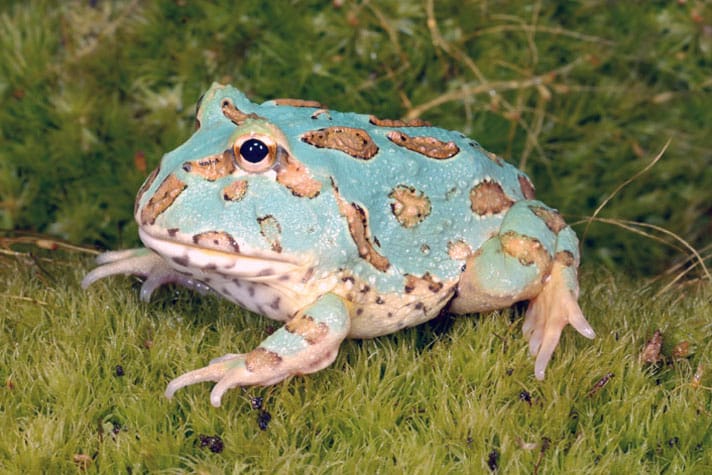The Pac-Man frog looks forward to an exciting future of new species and color morphs.
I recall, as a child, reading folk tales of large tropical frogs in the Argentinian Pampas that attacked grazing cattle and horses, biting their tongue or lips, and not letting go until the animal died of starvation. The bite claimed to rival that of a monitor lizard! The accompanying photographs showed a comical-looking, wide-mouthed frog whose stunning, deep-forest-green body, marked with yellow reticulations and crimson highlights, was wider than it was long. Its short, stumpy legs appeared unable to lift its own body weight, and a pair of small horns over the eyes only added to its grumpy expression.
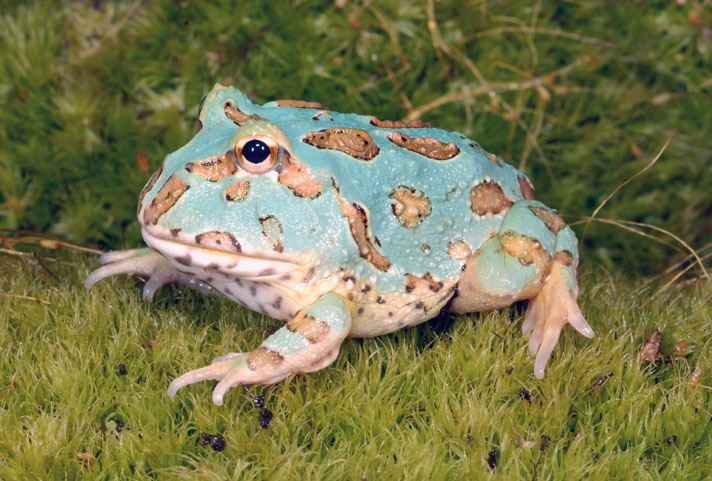
bill love
Different morphs, including Pac-Man frogs that exhibit blue coloration, have helped keep horned frogs at the peak of their popularity.
A few years later, these gelatinous giants began to appear in advertisements and television shows, adding to my interest. But it wasn’t until a trip to my local reptile store when I was a teenager that I got to experience a Pac-Man frog in the flesh. The beautiful, light green Cranwell’s horned frog (Ceratophrys cranwelli) was the size of a tennis ball and, sadly, already sold.
In the early 2000s, I finally got to own one for myself, swapping my first batch of captive-bred yellow-bellied toads for a single, golf-ball-sized, albino Cranwell’s horned frog that lasted only a matter of days. Despite the sour experience, it did not squelch my fascination with the mighty, hulking horned frog. Instead, I was more enthusiastic to master its care and captive breeding.
History of the Pac-Man Frog in the Hobby
Native to South America, the genus Ceratophrys currently contains eight species, and some of them were popular imports into the pet trade. As time passed and borders began to close on exporting horned frogs, the once-abundant supply began to dry up. With the commercial-scale, captive-breeding boom of the 1980s, however, herpetocultural pioneers, such as Philippe de Vosjoli and Robert Mailloux, fixed the future of the ornate horned frog, and by 1985 it was fast becoming a popular pet.
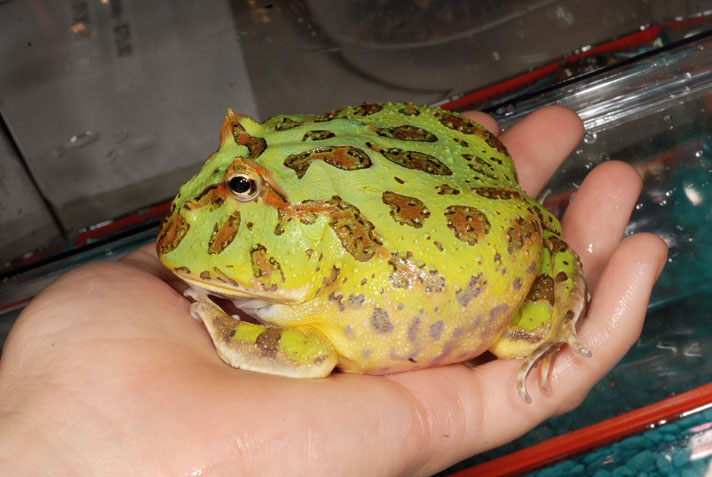
bill love
Handling horned frogs is not recommended. If it must be done, however, don’t get bitten and remember to wash your hands afterward.
Ornate horned frogs, also known as Argentinian or Bell’s horned frogs, are stunning beasts. Their fleshy, horn-like projections are small, but their ornate color schemes of greens, browns, yellows and reds more than make up for it when coupled with their large size, averaging 4 to 6 inches, and aggressive feeding response. They truly are mighty frogs to behold. In nature, they can be found in the humid, subtropical Pampas of Argentina, ranging into Uruguay and Brazil. They live a largely fossorial lifestyle, buried away for most of the year and emerging when stimulated by the warm summer rains in order to breed explosively in shallow, temporary pools.
During the late 1980s and early 1990s, the closely related Cranwell’s horned frog began to gain popularity. A slightly smaller species at 3 to 4 inches, and typically drabber brown in appearance, initially it was largely ignored by the trade. The introduction of its albino form by Kim Thomas in 1992, however, caused Cranwell’s horned frog to really take off, and by the mid-1990s, both species were firm favorites of hobbyists. With the albino’s bright yellow coloration, it’s easy to see how these near-round frogs with a penchant for eating anything and everything put in front of them got them the name “Pac-Man” frog, though the name is now used collectively in reference to all horned frogs.
The Cranwell’s horned frog, also known as the Chacoan horned frog, originated from the drier arid grasslands of the Gran Chaco of Argentina, Brazil, Bolivia and Paraguay. It is a slightly easier captive to many because it feeds well at a wider range of temperatures and humidity levels, and, from personal experience, it is a slightly easier species to breed naturally in captivity. These traits make for a more commercially viable prospect for the herpetocultural industry, and by the late 1990s, the Chacoan surpassed the ornate horned frog as the most popular tropical amphibian in the American pet trade. Today, they are shipped worldwide in large quantities.
Due to its popularity and large-scale propagation, the albino isn’t the only Cranwell’s color morph to have cropped up. Development of green strains started early on with light green juveniles that typically darken down as they mature. In the last few years, development culminated in the pastel and peppermint lines that show hints of blues and reduced markings. The albino strains also have been developed in several ways including light lemon yellows, limey green strains and some of the newer strains of albinism concentrate on bringing out the darker tints of oranges and reds.
Ideal Horned Frog Enclosure
Female horned frogs are the most impressive in terms of size, with the possibility of attaining almost twice the body mass of a male. They also have larger heads and generally a more aggressive demeanor. Males carry the typical traits used to sex many amphibians, such as nuptial pads on the first digit and loose skin on the throat, indicating the presence of the vocal sac. Vocalizations are loud and raucous, sounding almost like tortured ducks.
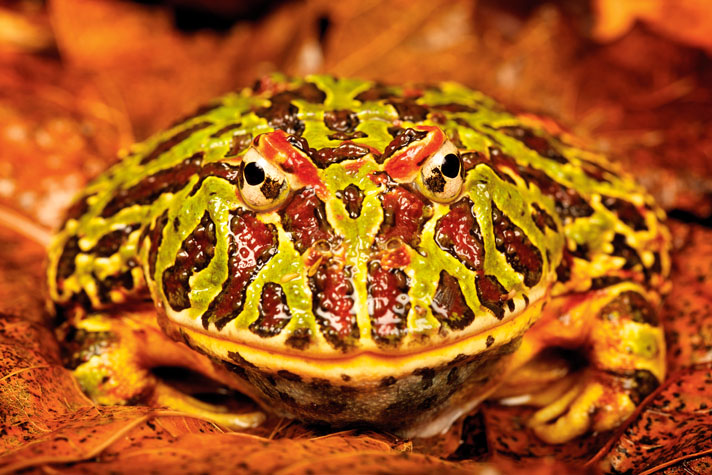
mark bridger/shutterstock
If provided with a substrate into which they can burrow, pet horned frogs will spend a lot of their time fully or partially buried.
Being largely inactive predators that are happy to sit in a hole and not move for weeks on end, horned frogs are the ideal pets for people with limited space and time. Despite their impressive size, their enclosures only need to include a floor area of eight to 10 times the size of the frog. So if your frog measures 2 inches in diameter, an adequate terrarium would have a 6-inch square of floor space; and a 6-inch-diameter frog would need an 18-inch cube or a 24-inch by 12-inch terrarium. The most important thing to remember is to house these highly cannibalistic and opportunistic feeders alone, or else you risk the death of both animals.
Your frog’s setup can be as simple or elaborate as you wish. My preference is a loose, free-draining substrate with a coconut-fiber base blended with a small amount of sphagnum peat moss (to slightly raise acidity) and composted fine orchid bark. The moisture content of this mix is adjusted easily, and adding orchid bark helps to aerate the substrate, keep the mix from going stagnant and prevent the smells associated with damp soils. Provide a substrate depth of 4 to 6 inches for adults and sift it regularly to remove feces. You easily can plant a display terrarium with robust houseplants, such as Chinese evergreen, Pothos/Scindapsus and temperate ferns. But you might want to leave the plants in their pots to prevent them being dug up, and to make it easier to clean the substrate.
Horned frogs spend a large portion of their time fully or partially buried in the substrate, and they use their enlarged, spade-like metatarsal tubercle to dig down backwards with surprising speed. Even though they prefer to burrow than to utilize hides, it is a good idea to provide some kind of hide in the form of cork bark flats or broken terra cotta pots. While the frog might ignore it, such décor provides areas of slightly higher humidity and moisture level within the substrate underneath, giving the frog the option of a humidity gradient within the terrarium.
Want To Learn More?
Daytime temperatures are best maintained around 79 to 82 degrees Fahrenheit with a nighttime drop to around 75 degrees. Maintain ambient humidity at around 70 percent. A light misting in the early evening paired with the timing of heaters and lighting apparatus will help raise nighttime humidity slightly. For Cranwell’s frogs, you can allow the humidity to drop slightly during the day without issue.
I find that ornate horned frogs fair best when kept at the higher end of the temperature range because they feed well at these temperatures and less well when kept slightly cooler. On the other hand, Cranwell’s keep their appetites to fairly low levels.
You can provide some form of lighting to establish a day/night cycle; a low-wattage fluorescent tube, compact fluorescent or LEDs are ideal. These animals do not require UVB lighting. If you do provide it, then stick to a low-level output such as a 2 percent. Avoid UVB lights altogether if housing albinos.
All amphibians need constant access to fresh water, so provide a shallow bowl that is heavy enough to prevent it from being tipped by the frog’s burrowing actions. It is not unusual for horned frogs to defecate in their water bowl, especially if the water is kept warm, so check it daily and keep it as clean as possible.
Simplified setups are popular with breeders and hobbyists maintaining large collections. These might range from decoration-free terrariums with just a few inches of substrate and a bowl of water to almost sterile setups consisting of a layer of filter foam or filter wool matting in a film of water that easily can be rinsed and replaced, allowing for daily cleaning. Setups of this style do not allow for natural burrowing behaviors. Though the frogs will adapt to this, such arrangements really are best left to commercial facilities dealing with large quantities of young frogs.
When housing multiple frogs, do not place enclosures directly beside each other without obscuring the view from one tank to the next, because these frogs tend to lunge at each other, smashing their noses on the glass and resulting in nose rub or worse, misshapen jaws. Likewise, avoid leaving pots of live foods in view.
Feeding the Pac-Man Frog
Ceratophrys are ambush predators. With their eyes positioned directly on top of the head, they can remain buried up to their eyes in the substrate. With their horn-like projections aiding in their camouflage, they will wait for an unsuspecting insect, frog, lizard or rodent to pass by. Then they lunge forward to grab their prey. Juveniles are known to raise a hind limb over their head as a caudal lure to attract other frogs or lizards to meet their fate, but this behavior rarely is seen in captivity due to the ready supply of food available to them.
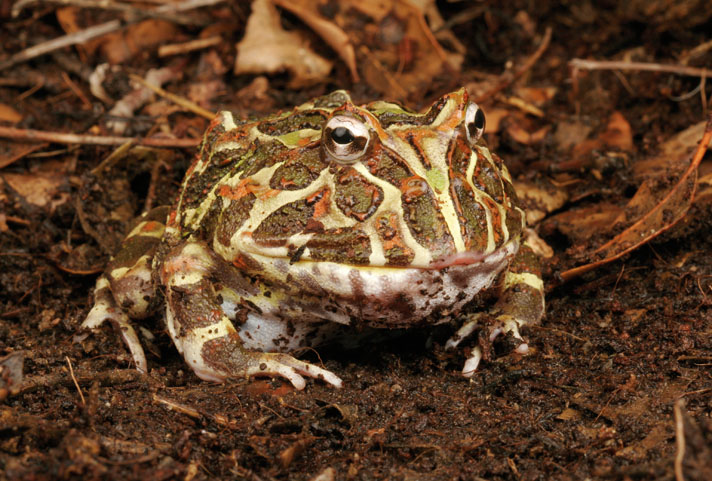
audrey snider-bell/shutterstock
The Pac-Man frog will eat almost any animal it can fit in its mouth.
Offer food to young horned frogs daily. Their diet consists largely of live insects, including earthworms, crickets and roaches. Small, live-bearing fish or pinky mice may be fed occasionally to provide variety. Let young frogs consume as much as they will take in a sitting, from several invertebrates to a single, larger prey item.
Placing a suitably sized earthworm in a shallow film of water can tempt young frogs that appear to be difficult feeders. The wiggling motion is similar to that of a tadpole and encourages a feeding response.
Juveniles grow quickly and can reach adult size in as little as six to nine months. Because of this rapid growth, they require a good supply of calcium and vitamin D3 in the diet to ensure healthy bone development. Ideally, dust a good quality calcium and multivitamin supplement over food at every other meal. You may cut down the frequency of supplementation as they mature.
Adults can be fed less often than froglets, only requiring a good meal every few days or even once a week. They generally feed whenever they are given the chance, so it is very easy to overfeed them, negatively affecting the frog’s health. A fit adult horned frog should be slightly longer than it is wide.
Suitable food for adult horned frogs includes locusts, roaches, lob worms, fish, prawns, shrimp and pre-killed rodents. Large females also can eat day-old chicks. Only offer rodents and chicks occasionally, and the frogs might need to wait a week or more before feeding again.
Frogs can become addicted to mice if fed them often, and this can result in their refusal to eat invertebrates. Therefore, provide as varied a diet as possible and then supplement only one feeding every other week.
If a newly acquired animal proves to be difficult to get feeding, avoid resorting to force-feeding, because this can cause more harm than good. Place stubborn animals that initially refuse to feed in a darkened terrarium kept warm and humid, and add several large crickets, roaches or locusts with them. Note that a horned frog of a healthy weight and condition can go for months without feeding.
Be careful when putting food into the enclosure, because these frogs are aggressive feeders. They have strong jaws and a row of very sharp maxillary teeth running along the upper jaw with a pair of large odontoid projections on the lower jaw designed to keep hold of the slippery frogs that form their natural prey. A bite from a large horned frog will hurt and often draws blood. If accidentally bitten, it is best to wait for the frog to let go by its own accord rather than pulling away, as you risk a more serious cut from the lower odontoid projections.
Personally, I think the worst part of a bite is the sticky tongue mucus that takes some scrubbing to remove. You can see it if your frog ever strikes at the terrarium glass in an attempt to eat something moving on the outside.
Handling horned frogs is not advisable, but when you need to move them for cleaning or health checks, approach from behind and avoid putting your fingers in front of their mouths.
Horned Frog Lifespan and Aestivation
Well-cared-for horned frogs can live more than 15 years, and those that experience regular aestivation can reach 25 to 30 years. Because aestivation comes with its own dangers, only frogs in the best possible health should be subjected to the stresses involved with this process.
If you choose to aestivate your horned frog, it can be done at any time of year. However, it’s usually best timed to coincide with the winter months to make it easier to achieve the lower temperatures required. Prior to aestivation, the frogs should be well fed to ensure they have sufficient fat reserves to see them through the dormant period, and they should be starved shortly before entering aestivation to ensure an empty digestive system. During aestivation, the frog’s metabolism will slow to such a rate that any undigested food will decay and become toxic to the animal. The aestivation itself requires a gradual drop of temperature over a period of one month to a low of 60 degrees, while simultaneously allowing the substrate to dry. This encourages the frog to burrow deep and cocoon itself in multiple layers of dry, shed skin to preserve the water within its body and avoid desiccation.
The aestivation period can last from weeks to several months, and it usually is advisable to aestivate younger frogs for a shorter period than fully grown adults. During aestivation, periodically check on the frogs to ensure they are aestivating correctly; any animals that are not keen to enter aestivation should be returned to normal maintenance and attempted again at a later date.
Once you are ready to awaken your horned frog, slowly begin to raise the temperature and re-moisten the substrate, mimicking the warm summer rains percolating down into the soil. It will take a while for the frog’s skin cocoon to soften enough for it to emerge and make its way back to the surface. At that time, the frog will shed and urinate profusely, so regular misting and cleaning is required. Offer only small amounts of food at first. By the time the temperature and humidity levels return to normal the frog’s appetite also should return, as voracious as ever.
Andrew Tillson-Willis has bred amphibians for more than 15 years and has gained valuable firsthand knowledge from working with a wide range of species, some seldom seen in captivity. In 2002 he established Pollywog (pollywog.co.uk) as a source of captive husbandry and propagation information.

